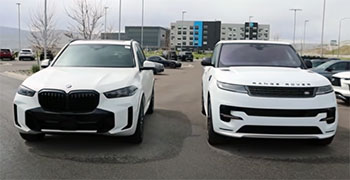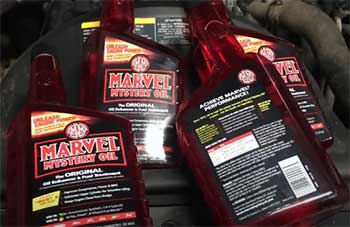I’ve always been fascinated by luxury SUVs. There’s something about their blend of power, comfort, and style that makes them irresistible.
When it came time to choose between the BMW X5 and the Range Rover Sport, I found myself torn. Both are giants in the luxury SUV world, promising performance, prestige, and practicality. In this article, I’ll share my journey comparing these two vehicles, breaking down their strengths and weaknesses to help you decide which one suits your lifestyle.
From driving dynamics to interior opulence, I’ll cover it all with a detailed pros and cons analysis.
Comparison Table: BMW X5 vs. Range Rover Sport
| Feature | BMW X5 | Range Rover Sport |
|---|---|---|
| Starting MSRP | $65,700 | $83,600 |
| Engine Options | 3.0L Turbo I6, 4.4L Twin-Turbo V8, PHEV | 3.0L Turbo I6 (Hybrid), 5.0L V8, PHEV |
| Horsepower (Base) | 335 hp | 355 hp |
| Fuel Economy (Combined) | 23 MPG | 18 MPG |
| Towing Capacity | 7,200 lbs | 7,716 lbs |
| Boot Space (Rear Up) | 650 liters | 835 liters |
| Ground Clearance | 8.3 inches | 11 inches |
| Infotainment Screen | 14.9-inch Curved Display | 13.1-inch Pivi Pro Touchscreen |
| Seating Capacity | Up to 7 (optional third row) | 5 |
| Off-Road Capability | Moderate, road-focused | Exceptional, Terrain Response 2 |
| Reliability | Average (BMW 16th in 2022 survey) | Below Average (Land Rover 31st in 2022) |
My Journey with Luxury SUVs
I’ve driven my fair share of SUVs, from rugged off-roaders to sleek city cruisers. When I decided to upgrade to a luxury model, the BMW X5 and Range Rover Sport topped my list.
Both have reputations for delivering premium experiences, but they cater to slightly different desires. The X5 leans toward sporty performance, while the Range Rover Sport emphasizes opulence and off-road prowess.
To figure out which one was right for me, I took them for test drives, pored over specs, and weighed what mattered most: driving feel, interior comfort, tech, and long-term ownership.
Performance: Power and Precision

Let’s talk about what makes these SUVs move.
The BMW X5’s base model, the xDrive40i, comes with a 3.0-liter turbocharged inline-six engine pumping out 335 horsepower.
It’s smooth, responsive, and paired with an eight-speed automatic transmission that shifts like a dream.
During my test drive, the X5 felt telepathic in Sport mode, accelerating with a confidence that made me forget I was piloting a two-ton vehicle. For those craving more power, the 4.4-liter twin-turbo V8 in the X5 M50i delivers 523 horsepower, turning this SUV into a rocket.
The Range Rover Sport, on the other hand, starts with a 3.0-liter inline-six mild-hybrid engine producing 355 horsepower. It’s no slouch, but it feels more relaxed than the X5. In Comfort mode, it glides over roads with a serene, almost regal quality. Switch to Dynamic mode, and it stiffens up, but it still doesn’t match the X5’s razor-sharp handling.
For thrill-seekers, the Range Rover Sport’s 5.0-liter supercharged V8 offers 518 horsepower, giving it a throaty roar that’s hard to ignore. However, I noticed more body roll in corners compared to the X5, which hugs the road like a sports sedan.
If you’re after driving engagement, the X5 takes the lead. Its steering is precise, and the optional air suspension smooths out potholes while keeping things composed. The Range Rover Sport, while capable, feels heavier and less eager to be hustled. But where it shines is off-road.
With Terrain Response 2 and seven terrain modes, it tackled muddy trails during my test drive with ease, something the X5 couldn’t match. If your adventures take you off the pavement, the Range Rover Sport is your go-to.
Interior: Comfort Meets Craftsmanship
Stepping inside the BMW X5, I was greeted by a cabin that’s both modern and functional. The materials—leather, wood trim, and brushed aluminum—felt premium, though not overly ostentatious. The 14.9-inch Curved Display is a tech lover’s dream, housing BMW’s iDrive system, which is intuitive and packed with features like wireless Apple CarPlay and Android Auto.
The seats are supportive, with 4-way lumbar adjustment standard, but I had to add the Climate Comfort Package to get heated and ventilated seats. Cargo space is solid at 650 liters with the rear seats up, expanding to 1,870 liters when folded. The optional third row is a bonus for families, though it’s tight for adults.
The Range Rover Sport’s interior, however, felt like stepping into a luxury penthouse. The white leather in the model I tested was stunning, and the minimalist dashboard design exuded sophistication. The 13.1-inch Pivi Pro touchscreen is sharp and responsive, though I found it less intuitive than the X5’s system. Standard features are generous: 20-way adjustable heated and ventilated seats with massage functions, a Meridian sound system, and four-zone climate control on higher trims.
With 835 liters of boot space, it outshines the X5 for cargo, and the air suspension can lower for easier loading. However, I noticed a slight creak from the glovebox, a reminder of Land Rover’s spotty build quality.
For sheer opulence, the Range Rover Sport wins. Its cabin feels more special, with thoughtful touches like chrome seat switches and a panoramic sunroof. But the X5’s tech-forward approach and optional third row make it more versatile for families or tech enthusiasts.
Technology: Cutting-Edge vs. Classy

Both SUVs are tech powerhouses, but they approach innovation differently.
The BMW X5’s iDrive system is a standout, offering a seamless interface for navigation, media, and driver assists.
Features like adaptive cruise control and rear cross-traffic alert require the $2,300 Driver Assistant Professional Pack, which feels like a stingy add-on for a $65,700 vehicle. Still, the system’s responsiveness and integration with Apple CarPlay and Android Auto made my test drive a breeze.
The optional Bowers & Wilkins sound system was a highlight, delivering crisp audio that rivaled a concert hall.
The Range Rover Sport’s Pivi Pro system, while visually appealing, took some getting used to. Its 13.1-inch touchscreen offers haptic feedback, but the menus felt less intuitive than the X5’s. Standard features like a 3D Surround Camera, Lane Keep Assist, and Traffic Sign Recognition give it an edge in driver aids.
The Meridian sound system, especially the 29-speaker 3D Surround option, was immersive, though I’d argue it’s not leaps ahead of the X5’s Bowers & Wilkins. For off-road tech, the Range Rover’s Terrain Response 2 and configurable modes are unmatched, making it a beast on rough terrain.
If you prioritize a user-friendly interface and cutting-edge driver assists, the X5 is your pick. But if you want a tech suite tailored for luxury and off-road adventures, the Range Rover Sport delivers.
Practicality: Space and Versatility
When it comes to daily usability, both SUVs hold their own. The BMW X5’s split tailgate and 40:20:40 split-folding rear seats make it a practical choice for families. Its 650 liters of boot space is ample, though it lags behind the Range Rover Sport’s 835 liters.
The X5’s optional third row is a game-changer for larger families, but it sacrifices some cargo space. I found the X5’s cabin spacious, with decent legroom in both rows, though the Range Rover Sport edges it out slightly for rear passenger comfort.
The Range Rover Sport’s limousine-like rear legroom and flat load floor make it ideal for long trips or hauling gear. Its air suspension can lower the vehicle for easier loading, and features like Trailer Stability Assist add confidence when towing.
With a towing capacity of 7,716 pounds, it outmuscles the X5’s 7,200 pounds, making it better suited for heavy trailers or boats. However, the lack of a third-row option limits its appeal for bigger families.
For versatility, the X5’s third-row option and split tailgate give it a slight edge. But if you prioritize cargo space and towing, the Range Rover Sport is the winner.
Fuel Economy and Running Costs

Luxury SUVs aren’t known for sipping fuel, and these two are no exception. The BMW X5’s base model achieves a combined 23 MPG, which is respectable for its class.
The plug-in hybrid xDrive45e offers 36 miles of electric range, making it a great choice for short commutes if you charge regularly.
Maintenance costs can be high, but BMW’s included maintenance for the first three years helps offset this.
Resale value is another strong point, as BMWs tend to hold their value well.
The Range Rover Sport, with its base model at 18 MPG combined, is less efficient. Its mild-hybrid system helps, but it’s still thirstier than the X5.
The plug-in hybrid P440e offers 46 miles of electric range, which is impressive, but charging infrastructure and habits play a big role. Land Rover’s reliability issues are a concern—my research showed they ranked 31st out of 32 brands in the 2022 What Car? Reliability Survey, compared to BMW’s 16th. This could mean higher repair costs down the line, and warranties are crucial.
If fuel economy and lower maintenance costs matter to you, the X5 is the smarter choice. But if you’re willing to trade efficiency for off-road capability and luxury, the Range Rover Sport still has appeal.
Reliability: A Critical Consideration
Reliability was a big factor in my decision. BMW has a mixed track record, with some owners reporting issues with electronics and complex engines.
However, the X5’s reputation is bolstered by BMW’s included maintenance and extended warranty options. In contrast, Land Rover’s reliability is a known weak spot. The 2022 What Car? survey painted a grim picture for Land Rover, with frequent issues in electronics and build quality.
During my test drive, the Range Rover Sport’s glovebox creak and slightly jerky seat adjustments didn’t inspire confidence. For long-term ownership, the X5 feels like the safer bet, but a solid warranty can mitigate risks with either.
Driving Experience: Sporty vs. Serene
The BMW X5’s driving dynamics are hard to beat. On winding roads, it felt agile, with precise steering and minimal body roll. The air suspension, when equipped, soaked up bumps while keeping the ride taut.
In Sport mode, the engine and gearbox worked in perfect harmony, making every drive engaging. Even in Comfort mode, it felt composed, though the standard steel springs on some models can be harsh with run-flat tires.
The Range Rover Sport, by contrast, prioritizes comfort. Its air suspension glides over rough roads, and the high driving position gives a commanding view. In Comfort mode, it’s like floating on a cloud, but Dynamic mode revealed more body roll than I’d like.
Off-road, it’s untouchable, with adjustable air suspension and Terrain Response 2 making light work of tough trails. For city driving or long highway cruises, the Range Rover Sport’s relaxed demeanor is unbeatable, but it lacks the X5’s sporty edge.
Price and Value: What You Get for Your Money
Price was a sticking point for me. The BMW X5 starts at $65,700, making it significantly more affordable than the Range Rover Sport’s $83,600 MSRP. The X5’s lower price doesn’t skimp on features, but some—like adaptive cruise control—require costly packages.
The Range Rover Sport justifies its premium with standard features like a 3D Surround Camera, 20-way seats, and off-road tech. However, its higher trims, like the P440e Autobiography ($105,675), push it into a different league.
When I crunched the numbers, the X5 offered better value for daily drivers, especially with its fuel efficiency and included maintenance. The Range Rover Sport’s premium feel and off-road capabilities come at a cost, both upfront and in potential repairs.
If budget is a concern, the X5 is the practical choice, but the Range Rover Sport’s exclusivity might sway you if money is no object.
Read More: My Thoughts On Acura MDX Vs. Volvo XC90
Pros and Cons: Breaking It Down
BMW X5 Pros
- Sporty Handling: Feels like a sports sedan, with precise steering and minimal body roll.
- Fuel Efficiency: Up to 23 MPG combined, better than the Range Rover Sport.
- Tech Forward: iDrive system is intuitive, with a large 14.9-inch display and seamless smartphone integration.
- Versatility: Optional third row and split tailgate make it family-friendly.
- Value: Lower starting price and included maintenance for three years.
BMW X5 Cons
- Limited Off-Road Ability: Not built for serious off-road adventures.
- Add-On Costs: Key features like adaptive cruise control require expensive packages.
- Tighter Cargo Space: 650 liters lags behind the Range Rover Sport.
- Ride Quality: Standard steel springs can feel harsh with run-flat tires.
Range Rover Sport Pros
- Luxurious Interior: Opulent cabin with premium materials and generous standard features.
- Off-Road Prowess: Terrain Response 2 and adjustable air suspension make it a trail king.
- Spacious Cargo: 835 liters of boot space and limousine-like rear legroom.
- Towing Capacity: Up to 7,716 pounds, ideal for heavy trailers.
- Electric Range: PHEV model offers 46 miles of electric driving.
Range Rover Sport Cons
- Reliability Concerns: Land Rover’s poor track record could mean higher repair costs.
- Fuel Economy: 18 MPG combined is less efficient than the X5.
- Higher Price: Starts at $83,600, with top trims exceeding $100,000.
- Less Agile: More body roll and less sporty handling than the X5.
My Verdict: Which One Wins?
After test-driving both SUVs and weighing their features, I leaned toward the BMW X5. Its sporty handling, better fuel economy, and lower starting price made it the practical choice for my daily commutes and occasional road trips.
The optional third row and included maintenance sealed the deal for me as a family-oriented driver. However, the Range Rover Sport’s luxurious interior and unmatched off-road capability were hard to ignore. If you crave prestige and plan to venture off-road, the Range Rover Sport is worth the premium—provided you’re okay with potential reliability risks.
Ultimately, your choice depends on what you value most. If you want a thrilling drive and better value, the X5 is your match. If luxury and off-road adventures are your priority, the Range Rover Sport delivers in spades. Test drive both, and you’ll know which one feels like home.
Read More: My Thoughts On Acura MDX Vs. Lexus GX
Frequently Asked Questions (FAQ)
BMW is generally more reliable than Range Rover. In the 2022 What Car? Reliability Survey, BMW ranked 16th out of 32 brands, while Land Rover was 31st, with frequent issues in electronics and build quality.
The BMW X5 is better for sporty handling, fuel efficiency, and tech, while the Land Rover Discovery excels in off-road capability and seating for seven. Choose the X5 for road-focused driving, the Discovery for rugged adventures.
The BMW X5 offers better value, fuel economy, and driving dynamics, while the Range Rover Sport provides superior luxury and off-road prowess. Your choice depends on whether you prioritize performance or prestige.
Pros: Sporty handling, 23 MPG combined, intuitive iDrive system, optional third row, lower starting price.
Cons: Limited off-road ability, costly add-ons, less cargo space (650 liters), harsh ride with standard suspension.
Conclusion
Choosing between the BMW X5 and Range Rover Sport isn’t easy—they’re both exceptional in their own ways. I found the X5’s sporty edge and affordability appealing for everyday driving, while the Range Rover Sport’s luxurious cabin and off-road skills tempted me for adventures. You’ll need to weigh what matters most: the X5’s precision and value or the Range Rover Sport’s opulence and capability. Test drive them, feel the difference, and pick the one that sparks joy for you. Your perfect luxury SUV is waiting.

